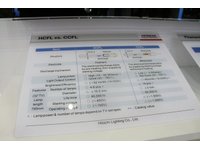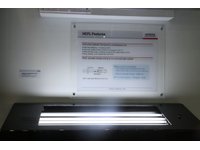Cheaper LCD Panels On the Way; Wallets Rejoice
Hitachi today demonstrated what it said will bring prices of LCD panels down significantly, while bringing quality up: hot cathode fluorescent lamps, or HCFL.


Most LCD panels shipping today are based on CCFL, or cold cathodes, but Hitachi told us today that its new HCFL technology not only gives superior brightness as well as lighting control, but utilize less energy and cost significantly less than emerging LED panels. With HCFL, LCD panels will achieve two to four times the watt output that a typical CCFL panel can do. Not only this, new LCD panels will also deliver more granular and accurate brightness controls. Most of all, Hitachi said that HCFL panels will require only two to three times less lamps, all while delivering more brightness.
On a 32-inch display, a HCFL panel will require anywhere from four to six lamps, while an older CCFL display can take up to 14 lamps. This of course, translates into significant power savings over the long haul.
When we asked about comparable LED panels, Hitachi indicated that there will be a huge cost savings. Current LED LCD TVs on the market command a high premium and we're excited to see a cheaper alternative show up.
Get Tom's Hardware's best news and in-depth reviews, straight to your inbox.
-
ksenter Aren't Hot Cathodes what they usually use in CRT's... I wish I knew more about this, I'm curious why they were previously using cold cathodes for LCDs and why they're switching now...Reply -
jerther I still prefer the now so cheap CRTs. Can't beat their 40+ years of proven reliability :) (And repairability... and uglyness... but I couldn't care less, 40$CAN for a 22 inches 1600x1200 85HZ screen for which I have spare parts, there's nothing to complain on this. Screw LCD.. and such :) )Reply -
joebob2000 ReplyMost of all, Hitachi said that HCFL panels will require only two to three times less lamps, all while delivering more brightness.
Oh come on, you're KILLING me.
For some reason, Excel 07 doesn't like the formula "two to three times less"... -
hellwig ksenterAren't Hot Cathodes what they usually use in CRT's... I wish I knew more about this, I'm curious why they were previously using cold cathodes for LCDs and why they're switching now...I believe they are. Its amazing how often people look backwards and find a more efficient solution. Who knows why they used cold cathodes, probably just something they always did with LCDs, and no one bothered to consider hot cathodes until now.Reply -
doomsdaydave11 joebob2000Oh come on, you're KILLING me.For some reason, Excel 07 doesn't like the formula "two to three times less"...Yea that made me cringe too.Reply
jacobdrjI have never repaired a CRT. Isn't that dangerous?Yea. I think there are reasons why you can't throw CRT units away either. Something bad lol.
Hot Cathodes? Initially I would have thought this would be a bad switch from cold cathodes, but if it really does mean cheaper equal, or better quality LCDs, then I'm happy. I've been waiting for a sub $200 28" monitor. -
lejay jertherI still prefer the now so cheap CRTs. Can't beat their 40+ years of proven reliability (And repairability... and uglyness... but I couldn't care less, 40$CAN for a 22 inches 1600x1200 85HZ screen for which I have spare parts, there's nothing to complain on this. Screw LCD.. and such )I bet it looks nice next to your LPs.Reply